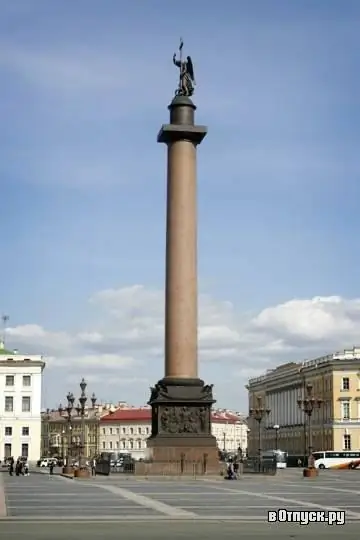
Description of the attraction
The Alexander Column is one of the most famous monuments of St. Petersburg. It is often mistakenly called the Pillar of Alexandria, after Pushkin's poem "Monument". It was erected in 1834 by order of Emperor Nicholas I in honor of the victory of his older brother, Emperor Alexander I, over Napoleon. Style - Empire. Installed in the center of Palace Square, in front of the Winter Palace. The architect was Auguste Montferrand.
The monument is made of solid red granite. Its total height is 47.5 m. The top of the column is decorated with the figure of the angel of peace, cast in bronze. It stands on a hemisphere, also made of bronze. In the left hand of the angel is a cross, with which he tramples the serpent, he stretches out his right hand to the sky. The features of Emperor Alexander I slip in the face of the angel. The height of the angel is 4, 2 m, the cross - 6, 3 m. The column is installed on a granite pedestal. It is noteworthy that it stands without additional supports, only under the influence of its own gravity. The pedestal is decorated with bronze bas-reliefs. On the side facing the palace there is an inscription: "Alexander I. Grateful Poccia".
Under these words you can see ancient Russian weapons and figures symbolizing Peace and Victory, Mercy and Justice, Abundance and Wisdom. On the sides there are 2 allegorical figures: the Vistula - in the form of a young girl and the Neman - in the form of an old man-Aquarius. At the corners of the pedestal there are two-headed eagles, laurel branches are clamped in their claws. In the middle, in an oak wreath, is the "All-Seeing Eye".
The stone for the column was recovered from the Piterlak quarry located in Finland. This is one of the grandest granite monoliths in the world. Weight - more than 600 tons.
The work was fraught with enormous difficulties. First of all, it was necessary to very carefully separate from the rock a solid piece of granite of the required size. Then, on the spot, this mass was trimmed, giving it the shape of a column. Transportation was carried out by water on a specially built vessel.
At the same time, in St. Petersburg, on the Palace Square, the foundation was being created. 1250 pine piles were driven to a depth of 36 m, and hewn granite blocks were laid on them to equalize the area. Then the largest block was placed as the basis for the pedestal. This task was carried out at the cost of tremendous efforts and a large number of mechanical devices. When the foundation was laid, there was a hard frost, and for better setting, vodka was added to the cement mortar. In the middle of the foundation was placed a bronze box with coins that were minted in honor of the victory of 1812.
The column seems to represent the exact center of Palace Square. However, this is not the case: it was installed 140 m from the arch of the General Staff building and 100 m from the Winter Palace. It was extremely difficult to set up the column itself. On 2 sides of the pedestal, forests up to 22 sazhens in height were built. The column was rolled along an inclined plane onto a special platform and wrapped with rope rings, to which the blocks were attached. Corresponding blocks were also installed at the top of the scaffolding.
On August 30, 1832, the column was raised. Emperor Nicholas I arrived at Palace Square with his family. Many people came to see this action. The people crowded in the square, at the windows and on the roof of the General Staff Building. 2,000 soldiers grabbed the ropes. Slowly the column rose and hung in the air, after the ropes were given up, and the granite block quietly and as if dropped to the pedestal. A loud "Hurray!" Flashed across the square, and the sovereign, inspired by his success, said to the architect: "Montferrand, you have immortalized yourself!"
After 2 years, the last finishing of the column was completed, and in the presence of the emperor and the 100 thousandth army, the ceremony of consecration was performed. The Alexander Column is the tallest monument in the world, created from a single piece of granite and III in height after the Column of the Great Army in Boulogne-sur -Mer and the London Trafalgar Column. It is higher than similar monuments in the world: the Parisian Vendome column, the Roman column of Trajan and the Pompey column in Alexandria.






